Chania town is vivid with a strong pulse. Sitting down at a café et the old harbor, you can take in all the noises, smells, and colors while feeling the sun on your face. Your days may be spiced up with cultural visits to museums and churches, bathing at the stunning nearby beaches, walks in the harbor, shopping in the endless maze of narrow winding streets, and dining at gorgeous restaurants. Also, enjoy the modern cafés and bars which are part of the Cretan life at its moments of relaxation.
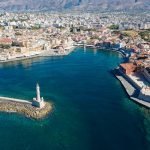
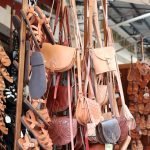
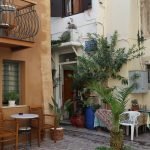

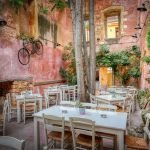
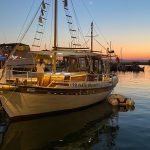
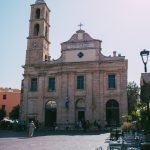
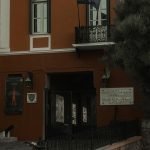

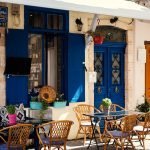
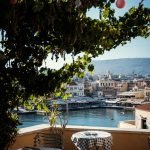

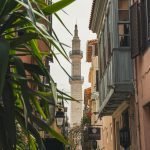

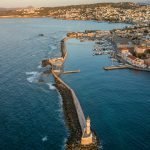
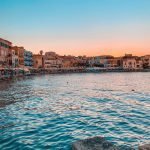
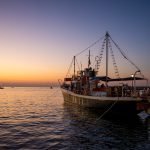

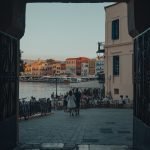
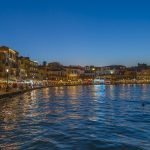
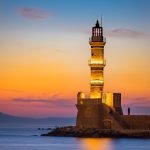

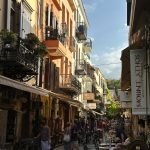
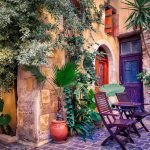

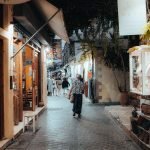
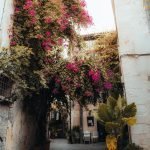
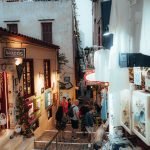
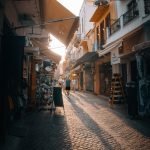


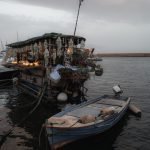


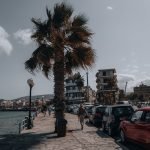
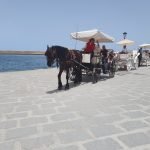
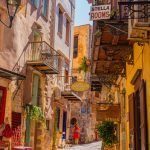
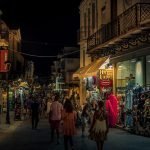

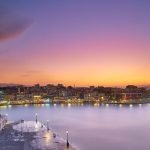
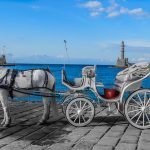
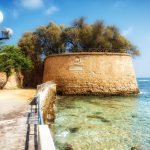
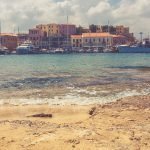
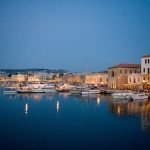
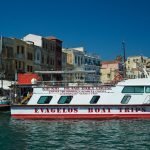
Chania – a town for strolling
Chania is a most charming town, perfect for walking. Walk through a mixture of elegant lounge bars and potter shops, and listen to the horse-drawn carriages in the alleys. Follow the pier all the way to the Venetian Lighthouse, and settle for one of the many romantic restaurants on your way. Find a romantic corner in one of the beautiful courtyards. Or enjoy the view and the evening breeze at a table on the quay next to the fishing boats.
Chania – Shopping and nightlife
Greek pottery shop in Chania’s harbour
In Chania, you will find plenty of fashion shops, cafés, and entertainment venues. Spend a morning enjoying all the colors in the large market hall with fruits, vegetables, and fish.
Walk to the town beach in Nea Chora
Like the Lighthouse and the castle, the Venetian quarters were built during the four hundred years when Venice ruled Crete. Walk along the sea to Nea Chora, a quiet neighborhood with fine beaches, to spend a day swimming and relaxing in the sun.
The Venetian Harbor of Chania City at sunrise
Chaniá is the second largest city of Crete and the capital of the Chaniá region. It lies along the north coast of the island, about 70 km west of Rethymno and 145 km west of Heraklion.
The official population of the former municipality is almost 56,000, while its metropolitan area has nearly 92,000 inhabitants. This consists of the city of Chaniá along with 7 towns and villages: Mournies, Souda, Nerokouros, Daratsos, Perivolia, Galatas, and Vamvakopoulo.
The city of Chaniá can be divided into two parts: the old town and the modern city which is the larger one. The old town is situated next to the old harbor and is the matrix around which the whole urban area was developed. It used to be surrounded by the old Venetian fortifications that started being built in 1538; of them, the eastern and western parts have survived. From the south, the old town is continuous with the new, and from the north, the physical border is the sea. The center of the modern city is the area extending next to the old town and especially towards the south.
Chania’s Old Town is considered the most beautiful urban district on Crete, especially the crumbling Venetian harbor. The borders of the Old Town are the mostly destroyed old Venetian wall (and bulwarks) and this has been the cradle of all the civilizations which were developed in the area. The central part of the old town is named Kasteli and has been inhabited since Neolithic times. It is located on a small hill right next to the seafront and has always been the ideal place for a settlement due to its secure position, its location next to the harbor, and its proximity to the fertile valley in the south. Nowadays it is a bit quieter than the neighboring areas of the west part of the district. The Splantzia quarter (next to the east part of Kasteli) is also largely untouched and very atmospheric. A plan for its future development is now under consideration.
The central Market Square (Agora) in Chania, Crete
Greek Orthodox cathedral in Chania, Crete
1) The central market or Agora in Chania 2) Greek orthodox cathedral in Chania
The squares and quarters of the old town
The main square of the Old Town (next to the west end of Kasteli) is the Eleftherios Venizelos Square (“Syntrivani“). It is the heart of the touristic activities in the area. Next to this (on the west side) lies the Topanas district, which used to be the Christian part of the city during the Turkish occupation. Its name comes from the Venetian ammunition warehouse (Top-Hane in Turkish), which was located there. The Jewish quarter (“Evraiki” or “Ovraiki“) was located northwest of the Old Town, behind the harbor and within the borders of Topanas. The whole Topanas area is generally very picturesque, with many narrow alleys and old charming buildings, some of which have been restored as hotels, restaurants, shops, and bars. This makes it a lively and colorful place, especially during the warm period from April to October. In the winter, it still remains a center of activities (especially the nightlife) but in a more quiet and atmospheric way.
Old mosque Janissaries or Kioutsouk Hassan Mosque in Chania Crete
The old Janissaries or Kioutsouk Hassan Mosque in Chania Town
Finally, a very distinctive area of the Old Town is the harbor itself and generally the seafront (“akti”). Akti Tompazi, Akti Kountouriotou, and Akti Enoseos (marina) all feature several historical buildings and a thriving nightlife. The main street that combines the modern town with the old town is Halidon Street.
The history of Chaniá
The ancient era
Hellenistic head of a woman from the cemetery of ancient Kydonia in the Archaeological Museum of Chania.
Chania is the site of the Minoan settlement the Greeks called Kydonia. Notable evidence for the existence of this Minoan city below some parts of today’s Chania was found by archaeological excavations in the district of Kasteli in the Old Town. This area appears to have been inhabited since the Neolithic era. The city reemerged after the end of the Minoan period as an important city-state in Classical Greece, one whose domain extended from Chania Bay to the feet of the White Mountains. The first major wave of settlers from mainland Greece was by the Dorian Greeks who came around 1100 BC. In 69 BC, the Roman consul Caecilius Metellus defeated the Cretans and conquered Kydonia to which he granted the privileges of an independent city-state. Kydonia reserved the right to mint its own coins until the third century AD.
The Byzantine era
The early Christian period under Byzantine rule (First Byzantine Period, 395–824 AD) and the rule of the Arabs, who called the settlement Al Hanim (“the Inn”), are not well documented. Under the Arabs, the Christian population was persecuted and moved to the mountains. The Byzantine Empire retook the city in 961 AD (Second Byzantine Period, until 1204 AD). In this period the Arabic name of the city was changed into Greek Chania. Byzantines began to strongly fortify the city in order to prevent another Arab invasion, using materials from the ancient buildings of the area. By this time Chania was the seat of a bishop.
The Venetian era
After the Fourth Crusade in 1204 and the fall of Byzantium in the Hellenic area, Crete was given to Bonifacio, Marquess of Montferrat, who sold it to the Venetians for 100 silver marks. In 1252 the Venetians managed to subdue the Cretans but in 1263, their rivals of Genoa, with local support, seized the city and held it until 1285, when the Venetians returned. Chania was chosen as the seat of the Rector (Administrator General) of the region and flourished as an important commercial center of a fertile agricultural region.
The Archaeological Museum
Interior of the Museum of Chania, Crete
The Archaeological Museum of Chania is a museum located in the former Venetian Monastery of Saint Francis at 25 Chalidon Street in Chania. It was established in 1962.
The exact date that the building was constructed is unknown although it was mentioned in writing as standing during the great earthquake of 1595 and being the largest in the city. It served as a Venetian church inhabited by Franciscan monks and became an important monument of the city.
The new archaeological museum of Chania
A new museum building constructed in the Chatzidakis Camp in the historical Chalepa area of Chania is overlooking the sea. The modern building, designed by Theofanis Bobotis, who also designed the Patras Museum, covers 6,500 square meters, including 1,800 square meters for exhibition halls, 140 square meters for the gallery, and a 140-seat amphitheater. The new archaeological museum of Chania also includes interior and open-air exhibition areas, skywalks, a shop, a cafeteria, and other visiting rooms.
Collection of Minoan and Roman artifacts
The museum contains a substantial collection of Minoan and Roman artifacts excavated from around the city of Chania and the surrounding prefecture, including pieces from the ancient cities of Kydonia, Idramia, Aptera, Polyrinia, Kissamos, Elyros, Irtakina, Syia and Lissos, and also from Axos and Lappas in Rethymno Prefecture. The museum has a Roman floor mosaic, depicting Dionysos and Ariadne.
The museum contains a wide range of coins, jewelry, vases, sculpture, clay tablets with inscriptions, stelae, and mosaics. The collection includes a clay sealing from Kasteli, with a representation of a Minoan city and its patron deity dated to the second half of the 15th century BC.
The Nautical Museum of Crete
External view of the Nautical Museum building (right), ChaniaThe Nautical Museum in Chania
The Nautical Museum of Crete is located in Chania. Its collection includes models of ships, nautical instruments, paintings, historical photographs, and war relics. The material is classified chronologically, starting from the Bronze Age up to our times.
The exhibits on the first floor include models of ancient ships, a model of the fortified town and port under Venetian rule, and a model that shows shipbuilding and repair buildings, with a rowing ship inside.
The second-floor exhibits include models of modern Hellenic Navy ships, destroyers, a missile boat, and a landing ship with trucks and APVs on board. The exhibits include the full-bridge of a destroyer and two torpedo propulsion units. A section of the museum is dedicated to the German invasion of Crete.
Center of Mediterranean Architecture
The Center of Mediterranean Architecture is a municipal enterprise that has its headquarters in Chania. It is part of the Architecture Network of the Ministry of Culture. It was founded in 1997 after the initiative of the Municipality of Chania and it is funded by the Municipality of Chania and the Ministry of Culture.
Part of the Center of Mediterranean Architecture, Chania, CreteCenter of Mediterranean Architecture, Chania
The main aim of the Center is to design and supervise various activities and programs focusing on space management and architecture. In the Mediterranean countries and specifically in Crete, there are many problems around space management and architecture, due to a lack of organization and control of the tourist industry that often threatens the environment and the local culture.
Architecture as an art is closely connected to the climate, environment, and other social, historical, and cultural conditions of each locality, as well as to its people and the needs of each community. However, the importance of architecture is often degraded because of the modern mentality of fast profit and investments that do not consider the effects on the wider community and environment. The Center of Mediterranean Architecture was founded in order to deal with these problems and put architecture back on stage. The main aim of the Center is to promote architecture as an art and as a necessity for a better quality of life and to express the “Mediterranean Identity” that makes this place special (from the official website of Chania Municipality).
Contact info: Centre of Mediterranean Architecture
31, Αkti Tombazi, Venetian Harbour, Chania, Crete
tel: +30 28210 40101/40201
Verekinthos, the Art & Crafts Village
Verekinthos is the mountain where, according to an ancient tradition, Idaioi Daktiloi, sons of Zeus and protectors of the Arts, once lived and were worshiped. They came to this mountain to teach age-old arts to men, such as Metallurgy, Pottery, Glassworks, and Weaving.
Today, the ancient name of this mountain emerges once again and takes its place in the same site. The above-mentioned age-old arts have been called up to take the place they deserve in people’s life.
“Verekinthos” Arts & Crafts Village
Souda interchange, Chania, Crete
website: www.verekinthos.com e-mail: info@verekinthos.com
Suggested visiting hours: 10.00-14.00 και 19.00-21.00 except Saturday evening and Sunday Many workshops are open all day long
The Botanical Park of Crete
Nearly 20 hectares of land are waiting to welcome you, full of fruit trees from all over r the world, herbs, and medicinal and ornamental plants in a park different from others, where the land’s formation and the region’s microclimate make it a paradise for hundreds of plants and animals.
Address: 5th km on the National Road of Hania, Fournes, Omalos
Read more at Botanical Park
Museums in the Chania region
- Archaeological Museum of Chania, 25 Halidon str. Tel. +302821090334 Open: 8.30-15.00 (except Mondays)
- Nautical Museum of Crete, Chania, Akti Koundourioti, Venetian Harbour. Tel. +302821091875/74484 Open: 9.00-16.00 (1/4-31/10), 9.00-14.00 (1/11-31/3)
- Μinoan Ship, Moro dock, Venetian Harbour. Τel. +302821091875 Open: Μay-Οct. Mon.-Fri. 10.00-15.00 & 19.00-22.30 (except public holidays)
- Historical Archives of Crete, Chania, 20 I. Sfakianaki str. Tel. +302821052606 Open: 9.00-14.00 (except Sat. & Sun.)
- Folklore Museum, Gavalochori, Apokoronas. Tel. +302825023222 Open: 9.00-20.00, Sat. 9.00-19.00, Sun. 10.00-13.00
- Folklore Museum “Cretan House”, Chania, 46b Halidon str. Tel. +3028210 0816 Open: 9.00-15.00 & 18.00-21.00
- Byzantine collection, Chania, Theotokopoulou str. Tel. +302821096046 Open: 8.30-15.00 (except Mondays)
- Ecclesiastic Museum, Monastery of Holy Trinity of Tzagarolon, Αkrotiri. Tel. +302821063310 Open: 8:00-20:00
- Ecclesiastic Museum, Gouverneto Monastery, Αkrotiri. Tel. +302821063319
- Ecclesiastic Museum, Monastery of Chrissopigi, Chania. Tel. +302821091125
- Ecclesiastic Museum, Monastery of Gonia, Kissamos. Tel. +302824022313
- War Museum, Chania, Tzobanaki Cassern. Tel. +302821044156 Open: 9:00-13:00 (except Sat. & Sun.)
- Chemistry Museum, Chania, 34c Eleftherios Venizelos str. Tel. +302821042504 Open: 9:00-13:00 (except Sat. & Sun.)
- Byzantine and Folklore Museum of Spilia, Kissamos. Tel. +30 28240 22080/22357. Open: 17:00-18:00, Sat. 11:00-12:00
- Typography Museum, VIOPA, Souda. Tel. +302821051003 Open: 10:00-18:00
- Museum of National Resistance, Therisso. Open all year round
- House of Eleftherios Venizelos: a. Mournies, Kydonia. Tel. +30 28210 93132/95250 Open: 18:00-21:00. b. Elena Venizelou sqr., Halepa, Chania (Eleftherios K. Venizelos Foundation). Tel. +302821056008
MORE ABOUT CHANIA GREECE
Chania (or Hania) is located on the westernmost side of Crete. Although some places have developed into tourist resorts, most beaches and villages keep their authentic style.
The northern side is more developed and lined up with luxurious tourist resorts and organized beaches. This is where the most popular beach villages are found.
On the contrary, the southern side is secluded and more traditional, with small seaside villages and unorganized beaches.
The most impressive beaches are Balos, Elafonissi and Falassarna, while there are innumerable other amazing beaches around the coastline, from organized resorts to secluded coves.
Due to the long history and rich culture, the region of Chania keeps evident its traditional architecture. A walk in the Old Town with the intense Venetian and Turkish architecture is a walk back in time. The Venetian port of Chania Town is the most characteristic spot of western Crete.
A drive around the prefecture will also bring you to many interesting sights. Explore the Medieval Castles you will find on your way, trek the many paths along with forests and gorges, visit the small local museums that depict the history and even try a chat with the locals at the traditional restaurants.
You will frequently see them sitting in the village square and enjoying a coffee under the shade of a huge tree. Apart from relaxing on a beach resort, grab the chance to experience the famous Cretan tradition and the warm hospitality!
In this guide, you shall find all the necessary information to organize your vacations there. From Chania, visitors can also make day excursions to other regions of Crete, including Rethymnon and Heraklion. Via the port of Heraklion, tourists can also head to the Cycladic islands of Mykonos and Santorini.
Holidays in Chania combine relaxation on amazing beaches, historical visits, and experience of authentic life.





